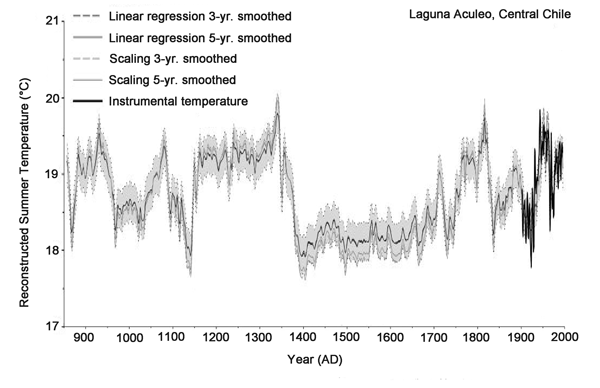Reference
von Gunten, L., Grosjean, M., Rein, B., Urrutia, R. and Appleby, P. 2009. A quantitative high-resolution summer temperature reconstruction based on sedimentary pigments from Laguna Aculeo, central Chile, back to AD 850. The Holocene 19: 873-881.
Description
Von Gunten et al. developed a continuous high-resolution (1-3 years sampling interval, 5-year filtered reconstruction) austral summer (December to February) temperature reconstruction based on chloropigments derived from algae and phototrophic bacteria found in sediment cores retrieved from Central Chile's Laguna Aculeo (33°50'S, 70°54'W) in 2005 that extended back in time to AD 850. This work provided, in their words, "quantitative evidence for the presence of a Medieval Climate Anomaly (in this case, warm summers between AD 1150 and 1350; ΔT = +0.27 to +0.37°C with respect to (wrt) twentieth century) and a very cool period synchronous to the 'Little Ice Age' starting with a sharp drop between AD 1350 and AD 1400 (-0.3°C/10 years, decadal trend) followed by constantly cool (ΔT = -0.70 to -0.90°C wrt twentieth century) summers until AD 1750." Looking at the graph of their data, the peak warmth of the Current Warm Period (CWP) occurred in the late 1940s. Since that time, temperatures have declined and then risen, but not to the level of warmth experienced earlier in the century. Peak warmth of the MWP is about 0.5°C higher than that recorded for the past two decades of the 20th century, which latter period is claimed by the world's climate alarmists to have been the warmest of the past thousand or more years. Hence, it is this latter period to which we compare the peak warmth of the MWP.





